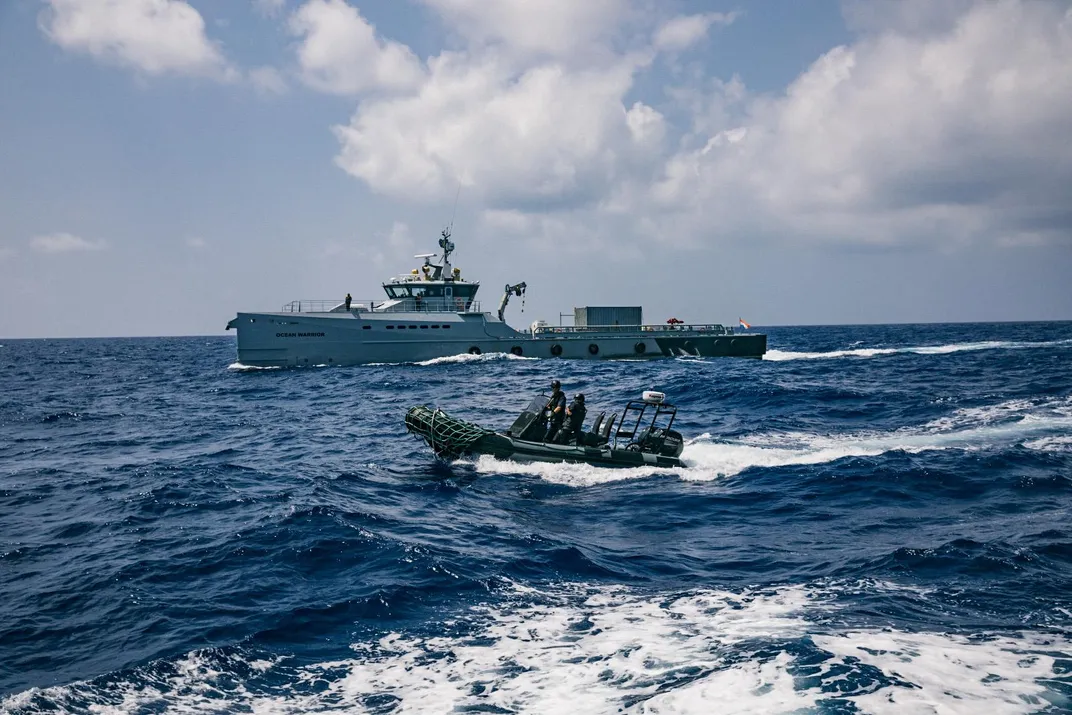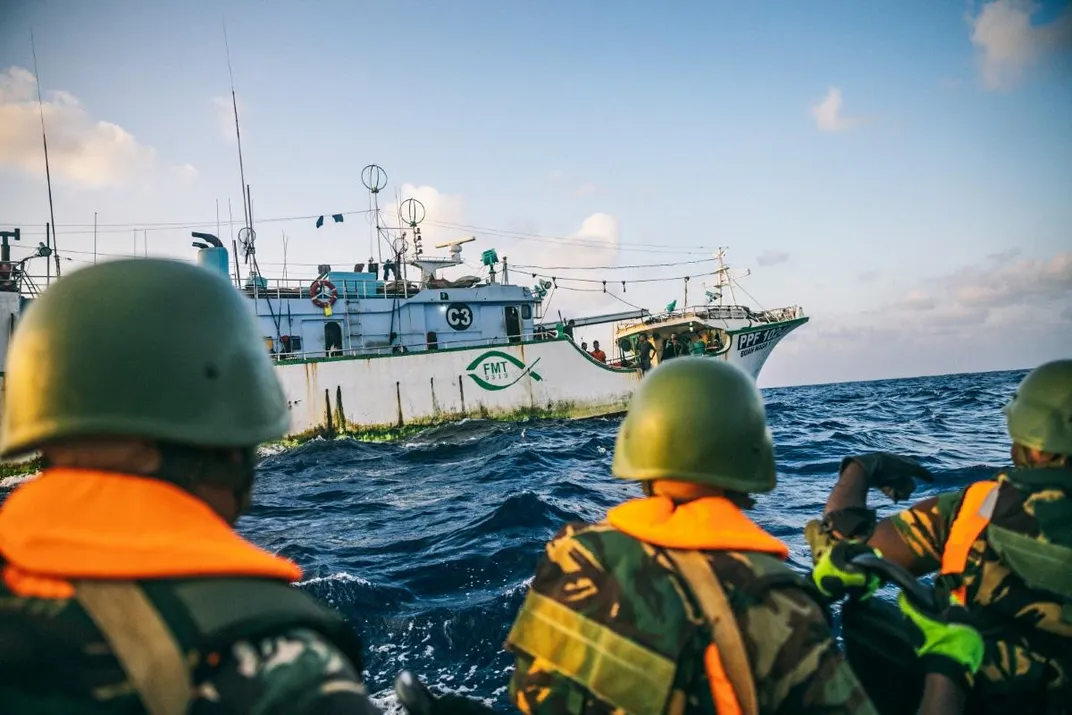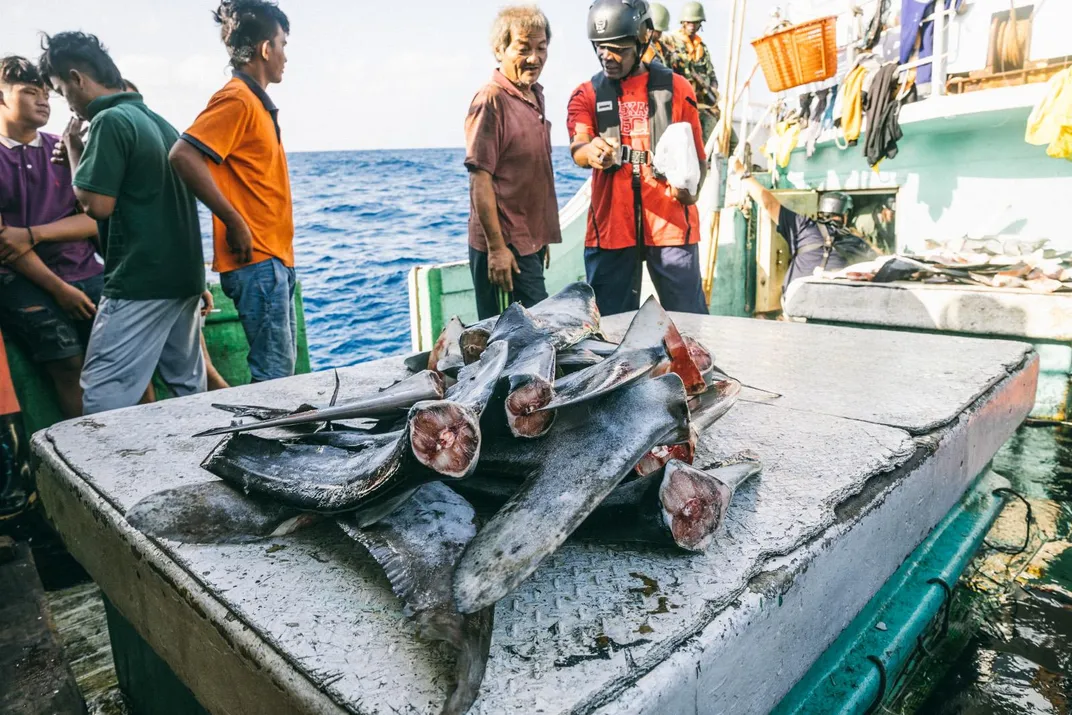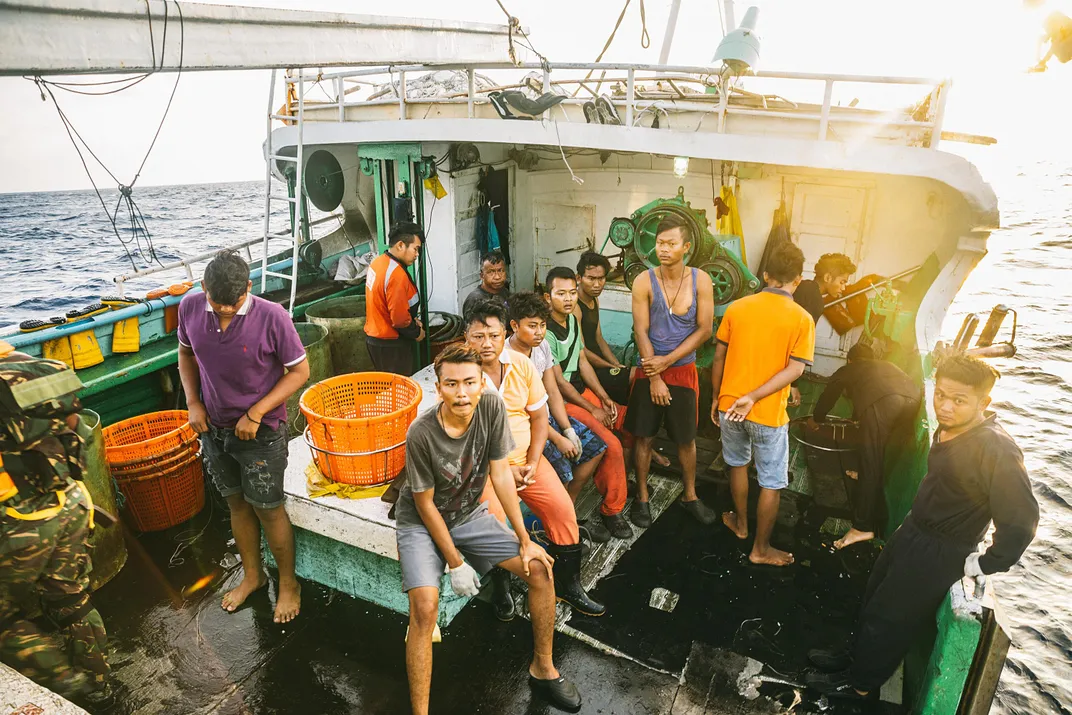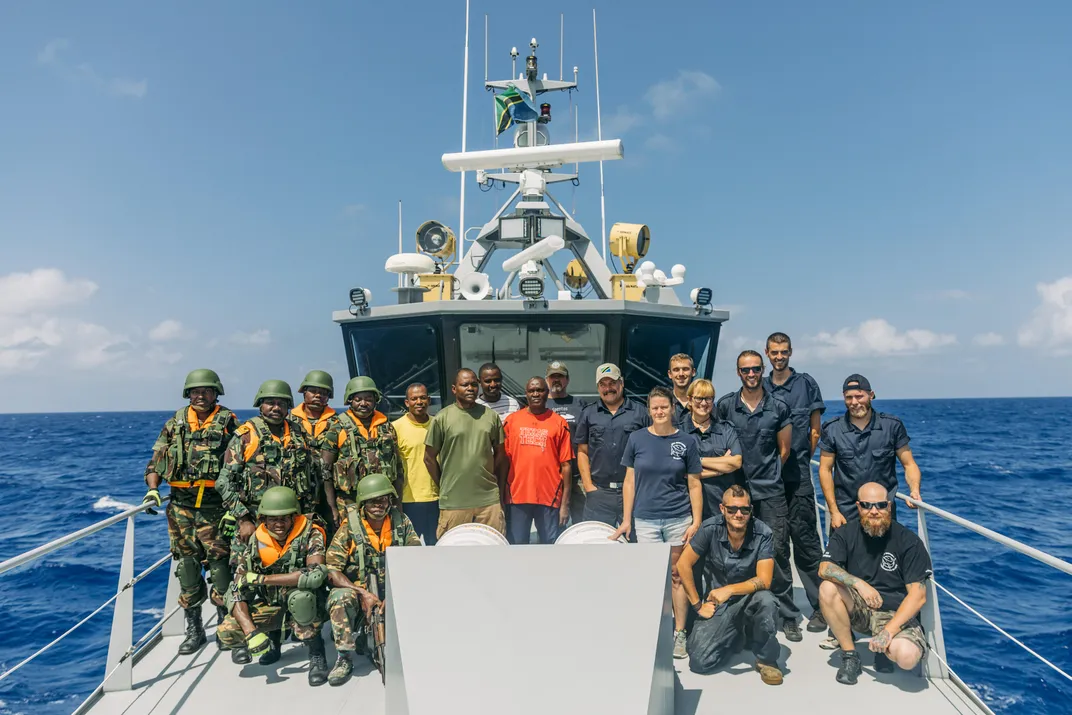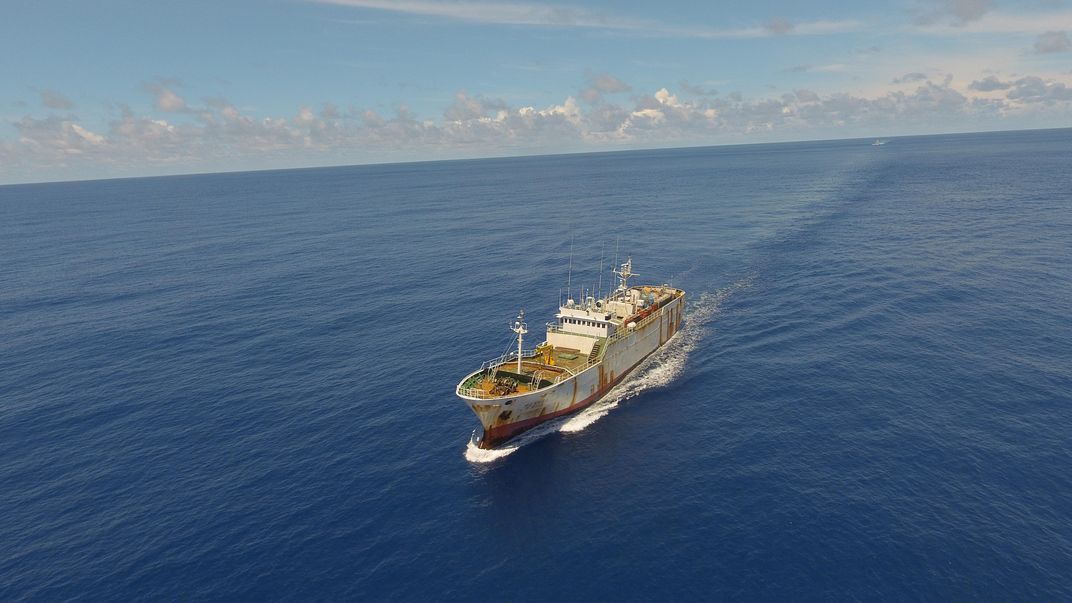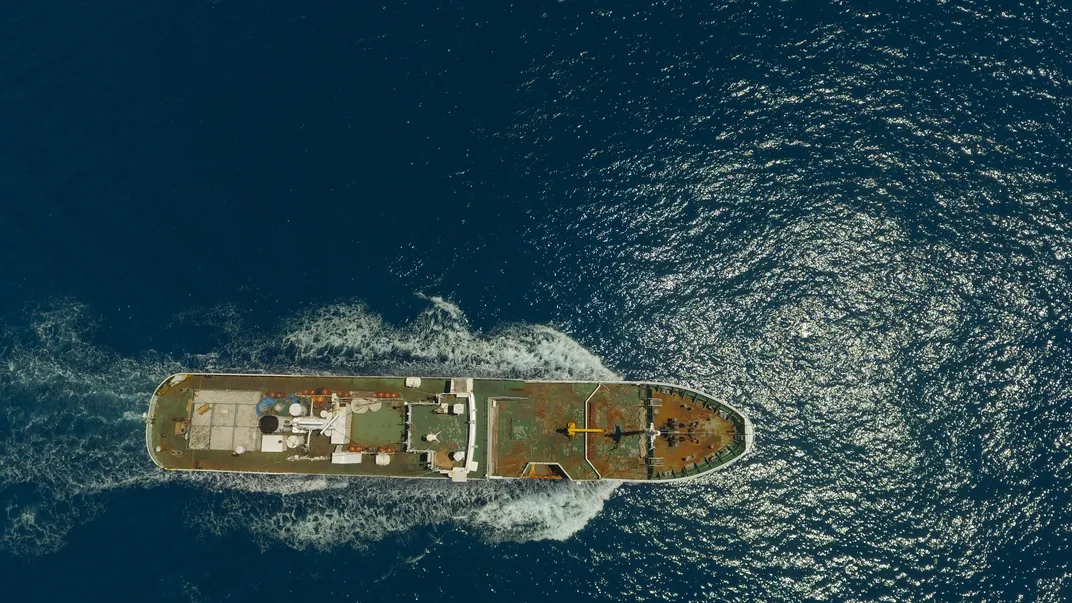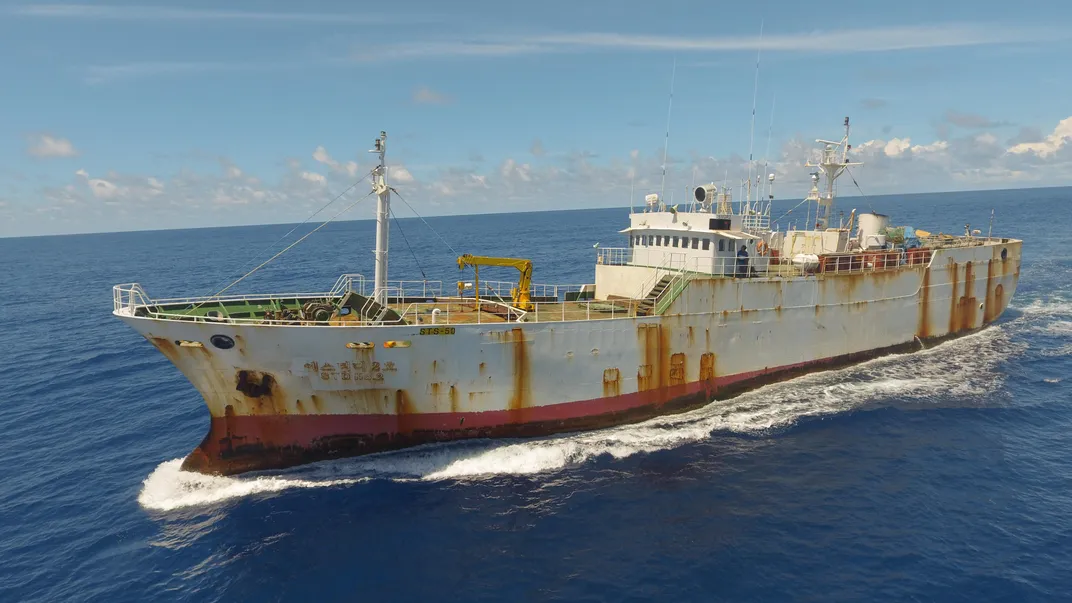The seas were calm and the winds were light when the Andrey Dolgov, a cargo ship flying the Cambodian flag, motored in from the South Atlantic Ocean toward Walvis Bay, Namibia, one March day in 2016. A crewman radioed ahead and asked for clearance to unload hundreds of thousands of pounds of frozen Antarctic toothfish pieces in sacks and boxes, and an additional 6,200 pounds of toothfish heads. The total—about 125 tons—would fetch more than $3.6 million on the wholesale market.
The ship’s forthright declaration raised suspicions. Namibia is part of a coalition of nations that have pledged to protect the Antarctic toothfish, which has a high market value and is biologically vulnerable. When port authorities started asking questions, the Andrey Dolgov’s crew said they had merely offloaded the fish from a Korean ship named the Bochang No. 3. But there was no Bochang No. 3 registered in South Korea. It seemed doubtful the Bochang No. 3 even existed. Namibia denied the ship entry and reported the encounter to international authorities. The Andrey Dolgov sailed on.
Two months later, the same rust-stained ship appeared in the Chinese port of Yantai, on the Yellow Sea. It carried what was most likely the same stock of frozen Antarctic toothfish, but the crew said the haul was Pacific cod for transshipment to Vietnam. This time, though, officials were on alert. Authorities in Yantai tested the flesh and identified it as Antarctic toothfish. They seized the stock and fined the Andrey Dolgov. Once again, though, the ship was allowed to leave.
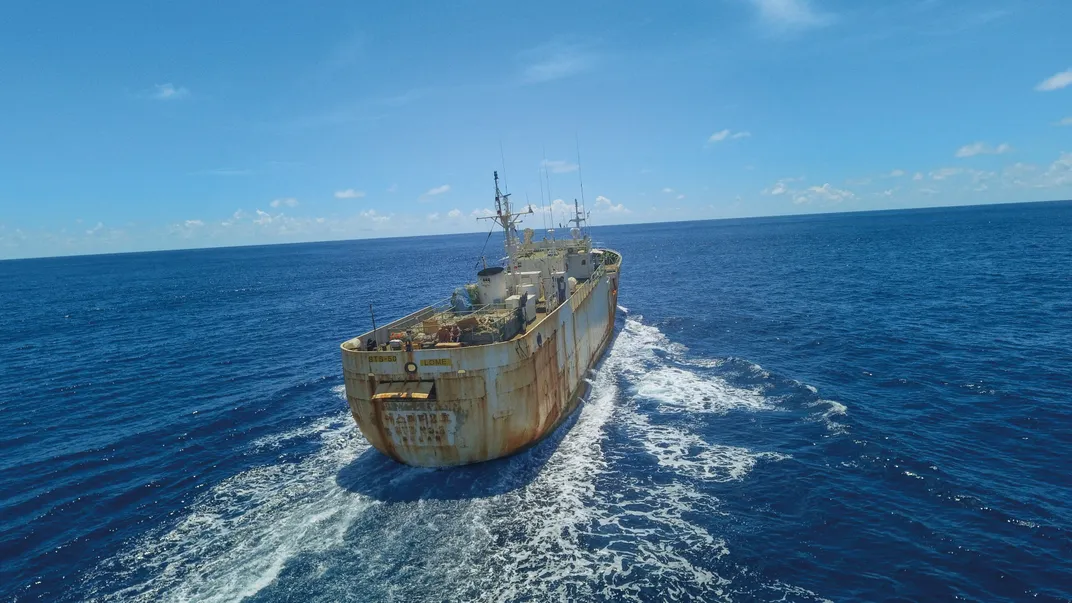
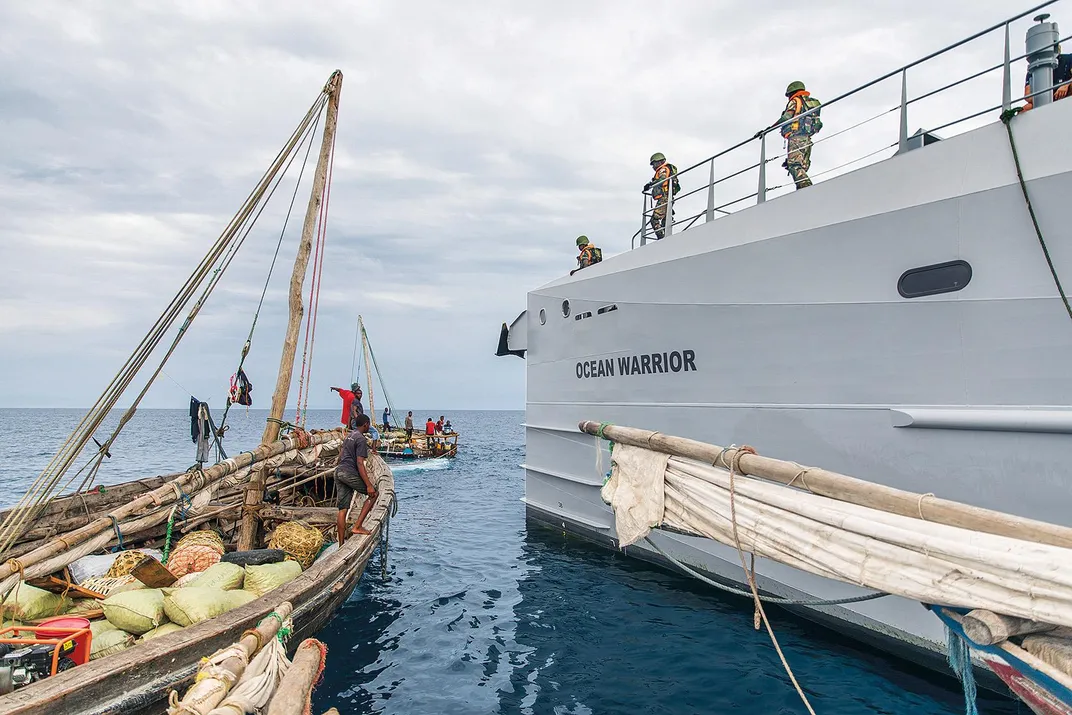
Meanwhile, in Lyon, France, Interpol Environmental Security investigators tracked the ship’s supposed owner, the Red Star Company, and its agent, Poseidon Company, to the South Korean port city of Busan. When Korean officials went to the company’s address and knocked on the door, they found an empty apartment and a landlord with few answers.
The Commission for the Conservation of Antarctic Marine Living Resources, an international regulatory body, put the ship on a black list of illegal, unreported and unregulated fishing vessels. Interpol sent out a purple notice, a call for more information about a criminal’s methods and devices.
In October 2017, more than a year after its appearance in Yantai, the ship showed up in the port of Dalian, on China’s Liaodong Peninsula. It was now calling itself the Ayda and flying a flag from the Togolese Republic. Once again, it attempted to offload Antarctic toothfish—about 275 tons. After Chinese authorities boarded the ship to collect information and DNA samples, it fled under cover of darkness.
As it headed away from China’s coast in May of 2016, the ship was fast on its way to becoming the most wanted pirate fishing vessel on the open water. Nearly a dozen countries would be roped into the search as Interpol tracked it across two oceans and four seas.
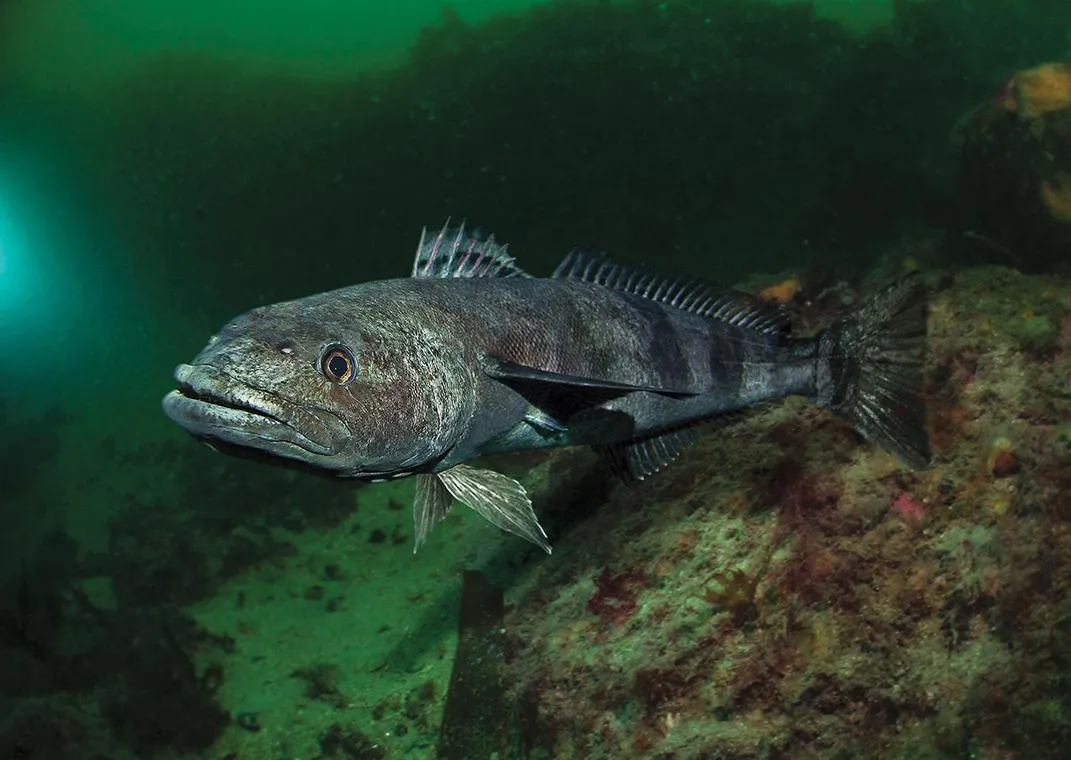
There was a reason the ship remained so elusive: It was a master of disguise. It changed its name six times, and flew the flag of as many nations. It disguised its electronic identification to confuse pursuers. Twice, it was detained—and escaped.
The tale of this pirate fishing ship, perhaps the most notorious of our time, shines a light into the shadowy universe of illegal fishing—the operators who fund it, the damage they cause to fragile ocean ecosystems and the ways they turn unsuspecting workers into indentured servants. It also shows what can happen when governments and nonprofits join forces on the wild, lawless seas. To piece together this story, I interviewed experts and officials from more than ten countries, reviewed hundreds of pages of documents and traveled to a remote Indonesian island to look for the ship’s captain.
The problem of ships like the Andrey Dolgov is more relevant to the average American than it might seem: A great deal of ill-gotten fish ends up in the United States, mixed with legitimate catch. And because the United States is one of the largest seafood markets in the world, American consumers play an unknowing role in perpetuating pirate fishing.
* * *
As the world’s population has grown, the demand for seafood has outpaced it. Seafood consumption shot up 30 percent from 35 pounds per person in 1998 to 45 pounds per person in 2018, according to the United Nations. The estimated global catch in 2018 (the latest year for which we have data) was 107 million tons, nearly twice what it was in the late 1960s. The fishers have been ramping up to meet growing demand, but the fish have been struggling to do so.
Gone are the days when small crews of men sailed out to sea with their nets. Nowadays, big fishing companies use helicopters, airplanes and even satellites to track down schools on the surface. Sonar helps them find bottom-dwellers. And once the fish are located, fishers deploy industrial-scale machinery: nets and long lines that stretch for miles, attached to motorized winches. In unscrupulous hands, these methods are notorious for damaging the seafloor, destroying the habitats of a wide range of marine creatures.
By the 1980s, some fish were in such rapid decline they were approaching the point of no return. One of the most dramatic examples is the Atlantic cod, once a dietary staple. Cod was so heavily fished by industrial trawlers off Canada’s Grand Banks that by 1992, the species’ population had been reduced to 1 percent of what it was in the 1960s. And the average size of caught Atlantic cod had decreased by 30 percent. Canada put a moratorium on cod fishing, abruptly ending an industry that supported entire communities.
The toothfish is an even trickier case because so much of its population lives outside the domain of any country. It comes in two species: the remote Patagonian toothfish and the even more remote Antarctic toothfish. Together, their range covers parts of the Southern Ocean, the Indian Ocean and the South Atlantic. For many years, both kinds of toothfish were minor bycatch for ships searching the cold southern waters for marbled and gray rock cod. But as those stocks dwindled in the 1970s, fishers started paying more attention to the yellow-eyed bottom-dwellers with jagged teeth that came up in their nets. As it turned out, toothfish flesh was white and delicate, without the dark muscle of stronger-swimming fish. Its taste was mild and it melted on the palate like butter. Even if you don’t think you’ve ever tasted it, chances are you have. It’s sold in the States as “Chilean sea bass,” though it is not a bass.
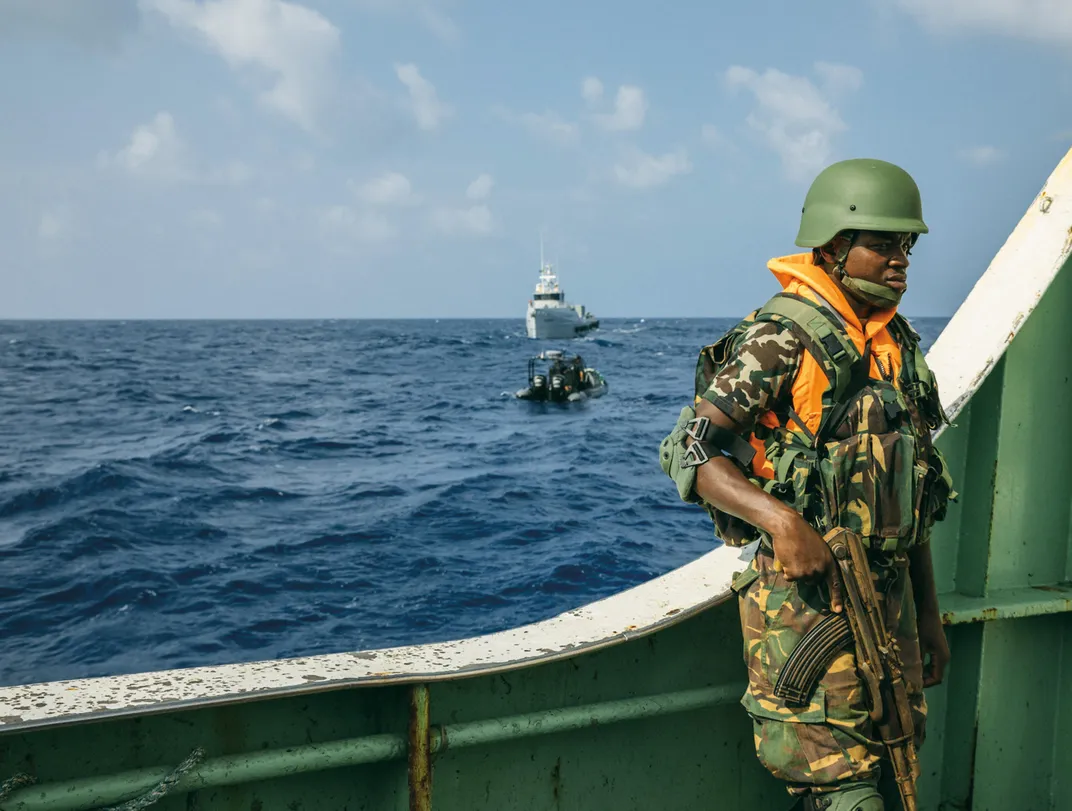
Since the mid-2000s, Antarctic toothfish has accounted for a larger share of the illegal market than its Patagonian cousin. The problem is that Antarctic toothfish is very easy to overfish because of its unhurried reproduction cycle. It grows to be about six feet long and lives an average of 31 years, but females don’t reach sexual maturity for more than 16 years.
In 1980, 15 countries signed the Convention on the Conservation of Antarctic Marine Living Resources, or CCAMLR, an agreement to protect the toothfish and other Antarctic species, ranging from mollusks to birds. Today, 26 countries are signatories, including the United States, China and the Russian Federation. Legitimate members of the fishing industry have also banded together to form the Coalition of Legal Toothfish Operators, which has offered rewards for information on poachers, and requires members to document their catch at every stage along the way to market.
Still, the demand for toothfish continued to grow, and illegal operators made up the difference. In 2002, the year after Bon Appétit magazine named Chilean sea bass the dish of the year, illegal fishing accounted for up two-thirds of toothfish supply. In 2016, there were 33 ships licensed to catch Antarctic toothfish. The Andrey Dolgov was not one of them.
* * *
How Many Are Caught?
Scientists say far more fish are captured than is acknowledged
Traditionally, fishing vessels had the freedom to go largely where they pleased. That changed in 1982, when the United Nations gave every country with a coastline the exclusive rights to the resources found in waters up to 200 nautical miles from its shore. Most countries keep track of the commercial catch in these areas, known as exclusive economic zones, and submit that data to the U.N.’s Food and Agriculture Organization. Yet those figures don’t begin to tell the whole story, as shown by these charts.
Daniel Pauly, a biologist at the University of British Columbia’s Institute for the Oceans and Fisheries, has worked for some 15 years to fill in the gaps. He and his team use thousands of sources to assemble a truer picture of what’s being taken from the oceans. To estimate U.S. totals, for instance, they add recreational and subsistence fishing as well as bycatch from major fisheries—none of it reported to the U.N.
Then there’s illegal fishing. Pauly says pirate vessels account for a substantial amount of catch, but it’s hard to measure. “That’s a huge problem in itself,” he adds. “It’s like saying we know there’s a substantial number of murders in my neighborhood but we don’t know how many.”
What Pauly and his team can calculate is how many foreign boats are fishing in other countries’ waters. This happens most often off the coasts of poor countries that can’t afford to patrol their own territories. To help piece together figures for West African countries, for instance, Pauly and his team use satellite images of fishing vessels and calculate how much fish each one would need to catch to stay in business. These totals often far exceed the U.N. reports. To further explore Pauly’s data—country by country and species by species—visit SeaAroundUs.org.

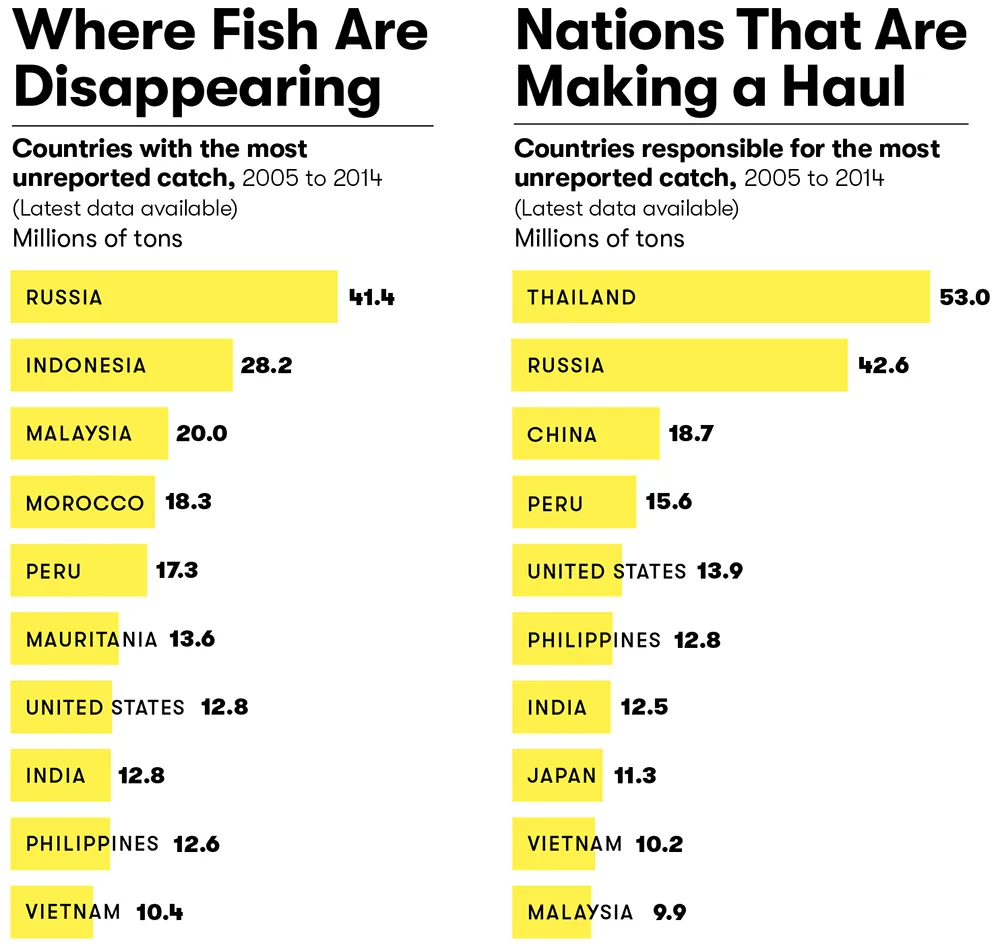
Somewhere along Russia’s eastern coast in late 2017, Aleksandr Matveev rode a tender out to a huge commercial fishing vessel. Matveev, a solidly built 55-year-old man with a broad, clean-shaven face and graying straight hair neatly parted on the side, had been hired by two men—identified later through text messages and other documents as Volodymyr Bulatetsky and Vita Sokirko—to take the ship to the Southern Hemisphere for toothfish.
The ship Matveev climbed aboard was no longer called the Andrey Dolgov or the Ayda. It bore a new name, stenciled in black paint: the STS-50. Another stencil stated that the vessel was registered in Lomé, the capital of Togo. Matveev would later claim he had no idea he was taking command of a floating criminal enterprise. But the evidence of its past registrations would have been scattered all over the bridge.
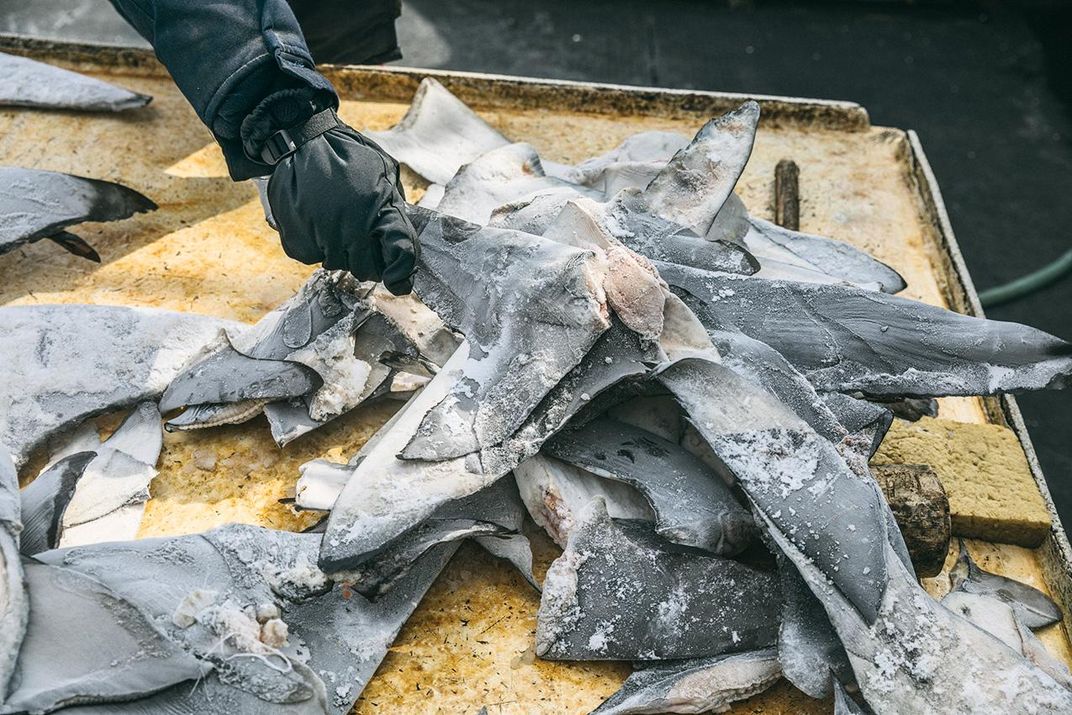
In addition to nine Russian and Ukrainian officers, his crew included 20 Indonesian sailors, known for being both highly capable and willing to work for between $350 and $380 a month. With Matveev at the helm, the ship headed southwest in early 2018 on its journey toward Antarctic toothfish grounds.
Like the cursed ship in “The Rime of the Ancient Mariner,” it was followed by misfortune. Four months later, the STS-50 was off Africa’s east coast without having been able to fish, according to accounts crew members would later give investigators. At some point, the ship’s refrigeration system malfunctioned, and the trip would be useless if the fish couldn’t be frozen immediately.
In early 2018, the STS-50 docked at Madagascar’s Port d’Ehola. Restrictions on the age and size of ships that could use the port prevented the STS-50—33 years old and about 175 feet long—from refueling there.
However, during its brief stay, an attentive port inspector—armed with Interpol’s purple notice for the Andrey Dolgov—recognized the vertical stripes of rust staining the hull and promptly made a call. As the STS-50 headed across the Mozambique Channel toward Maputo to refuel, it was tracked by Interpol and Fish-i Africa, a network of eight East African nations cooperating to fight illegal fishing.
* * *
It was early March 2018 when the STS-50 entered Mozambique’s territorial waters. An armed escort from the country’s navy, customs enforcement, maritime police and port authority intercepted the ship as it headed toward Port Maputo. They seized the crews’ passports and took the English-speaking first mate, Boris Mitchenkov, ashore for questioning.
The crew complied—but Matveev told the officials that his ship had an oil leak and might pollute their waters. So they allowed him to anchor the STS-50 off Portuguese Island, farther out in Maputo Bay. The ship’s crew agreed to respond to radio calls every two hours and keep the ship’s automatic identification system on at all times.
Ever since 2002, most ships weighing 300 gross tons or more have been required to continuously broadcast a unique nine-digit Maritime Mobile Service Identity number, or MMSI. The system was developed to prevent inshore ships from colliding. At first, VHF radio waves just pinged the numbers off shoreside receivers. But recent satellite technology has allowed monitors to read these ID numbers from space, meaning ships can be tracked anywhere. Turning off this signal is called “going dark.”
Over the course of two weeks, with the STS-50 rocking at anchor off the coast of Mozambique, Interpol investigators worked to get a firm digital lock on the ship. For this, they turned to Charles Kilgour, a sandy-haired British analyst with the fishing watchdog group OceanMind. (He now works for Global Fishing Watch, a nonprofit group whose website lets anyone view real-time satellite activity for fishing vessels over the internet.) As Kilgour collected data and satellite photos, it became clear that the STS-50 wasn’t broadcasting a unique number during its stay in Maputo. It was broadcasting a series of nine 1’s.
Over the past three years, more than 400 vessels—fishing boats, recreational craft, cargo ships and more—have broadcast the number 1-1-1-1-1-1-1-1-1 instead of a unique MMSI. Even when this is illegal, it’s not always devious. Some vessels enter a series of 1’s into the system simply because it’s easy. And some countries aren’t strict about enforcement.
In the case of the STS-50, using a generic number was clearly an attempt to throw authorities off its trail. “We had to process and clean the data to find this one tree in a massive forest so that we could see that one signal,” Kilgour recalled. He set to work cross-referencing the ship’s coordinates with other streams of data, including satellite images.
On the night of March 18, a worker on the night shift at Port Maputo noticed that the STS-50 was acting suspiciously. Up to that point, the ship had been dutifully radioing in every two hours. Suddenly the calls had stopped. And when the worker called the ship, nobody replied.
Then the ship went dark.
Inspectors zoomed out in a motorboat to check on the STS-50. But when they arrived at Portuguese Island, they found only the calm waters of the bay rippling in the moonlight where the vessel should have been.
* * *
When the STS-50 fled the Maputo harbor, Interpol had a lock on the ship’s real location, thanks to Kilgour’s work. They watched their computers as it headed north, then east. But catching the vessel would demand more than eyes on a screen. It also required boats on the water.
That help came from Fish-i Africa. The group’s member countries—Mozambique, Comoros, Kenya, Seychelles, Somalia, Tanzania, Madagascar and Mauritius—were often victimized by poachers because they lacked the resources to secure their own waters. (Recall that Somalia’s pirate epidemic of a decade ago began after poachers had pillaged the coast and put local fishers out of business.)
As it happened, just as the STS-50 was fleeing Port Maputo, an international nonprofit called Sea Shepherd was partnering with Tanzania, patrolling a section of the country’s waters that was near Mozambique. Sea Shepherd had previous experience tracking toothfish poachers. In 2014 and 2015, one of its ships had chased a Spanish-owned poaching vessel named the Thunder for 110 days, the longest open-ocean chase on record. The Thunder was the last remaining member of a fleet of illegal vessels that Sea Shepherd called the Bandit 6. The chase ended abruptly when the crew of the Thunder appeared to sink their own boat, calling out for rescue and sending evidence of their illegal activities to the bottom of the ocean. The Sea Shepherd captain, Peter Hammarstedt, was hailed as a hero and the story became the subject of a 2018 documentary called Chasing the Thunder.
The Sea Shepherd vessel now working with Tanzania was called the Ocean Warrior. It was helmed by a lanky Brit named Mike Dicks, a former Cathay Pacific Airways pilot now living in Australia. Onboard was a task force of Tanzanian officers from diverse agencies—immigration, drug enforcement, fishing, forestry—backed up by four marines.
Dicks and his crew studied the charts and surmised that the STS-50 was heading toward international waters in the Indian Ocean. To get there, they would have to sail through the territories of at least three nations. The Ocean Warrior would need each country’s permission to detain the STS-50 in that country’s territorial waters. Fish-i Africa representatives started working the phones.
As the Ocean Warrior changed course, the Indian Ocean lay flat before it. It was cyclone season, a time when the water was notoriously calm until it wasn’t.
* * *
For five days, the Ocean Warrior sailed on, getting updates on the STS-50’s position once a day. But the chase was not only a race to catch the ship. It was also a race against time. The Ocean Warrior had already been on patrol for weeks when it got the call from Fish-i Africa, and it had not been able to refuel.
As the Ocean Warrior closed in on the STS-50, it was clear it wouldn’t have enough fuel for a return journey if it followed the pirate ship much longer. If it ran only on its electric motors, it wouldn’t be able to move fast enough to catch the pirate vessel. Even if it did catch and board the ship, there weren’t enough people to guard the crew 24 hours a day for the lengthy journey back.
So after a roughly 1,000-nautical-mile chase, Dicks made the decision to call off the pursuit. “We were pretty upset,” Dicks recalled. “The gut-wrenching thing was we couldn’t do a Thunder and chase these guys around the world.” This time, though, the story didn’t call for a lone hero. The Ocean Warrior would be only one player in a vast international relay race. So Dicks got ready to hand over the chase.
On its last day following the STS-50, the Ocean Warrior pulled within a mile of the pirate vessel. Then its crew launched a foot-long drone. It was a brilliantly clear day, and the airborne high-resolution camera captured the STS-50 crew on the stern, as well as the boxes of nets on deck. It also got close-ups of the rust stains.
Then the Ocean Warrior pulled back. Matveev and his ship were alone, despite being one of the most wanted ships on the Indian Ocean.
* * *
The owners of the STS-50 had told Matveev that an agent in Maputo had sent their passports to South Korea, according to one official. That may have been why Matveev directed the ship through the Malacca Strait, a busy shipping lane between Indonesia and Malaysia.
For a pirate fishing vessel, sailing through Indonesian waters was more dangerous than facing down a cyclone. For four years, the Indonesian government had been waging an uncompromising war against illegal fishing. Susi Pudjiastuti, the former minister of maritime affairs and fisheries, had asserted that unauthorized foreign vessels not only undermined the country’s own fishing industry but often took part in modern-day slavery, luring Indonesian workers onboard under false pretenses. Under Pudjiastuti’s rules of engagement, navy ships were instructed to seize suspicious boats, detain the crews and sometimes, in incendiary displays of sovereignty, blow up the vessels.
Andreas Aditya Salim, at the time a young lawyer on Indonesia’s illegal fishing task force, was home watching TV on March 24 when a text from Interpol flashed on his phone’s screen at 10:25 p.m. It gave the STS-50’s latitude and longitude and reported that the ship was headed his way. It would enter Indonesia’s 200-mile exclusive economic zone in two weeks.
OceanMind and Interpol, meanwhile, kept monitoring the ship, and Interpol kept sending Salim regular updates. By the time it drew close, Salim had all the data: photographs of the ship, records of its course, Interpol’s purple notice and the report from Maputo proving the ship had broadcast a false MMSI. He brought the file to his supervisor, Mas Achmad Santosa, in the ministry’s marble-floored, sixth-story offices in downtown Jakarta. Salim recommended that the navy intercept the vessel.
On April 6, the Indonesian patrol boat KAL Simeulue II-I-26 set out from the Sabang Naval Base on the west Sumatra island of Weh. The patrol ship’s radar was broken, according to Salim, so the captain, Maj. Yoni Nova Kusumawan, had to rely on dead reckoning—using the STS-50’s trackline and rate of speed to estimate where and when to intercept it. It was an ironic low-tech conclusion to what had been an extended high-tech hunt. The voyage took about three hours, but the ship captain’s calculations were accurate. With its deck gun loaded and aimed, the Simeulue came up on the STS-50 at about 5:30 p.m.
Meanwhile, the pirate ship was catching the attention of Indonesians for another reason. As soon as it came within cellphone range, the crew members, frustrated by their confinement, confused about their journey, and angry that they hadn’t been paid in two months, had started calling their families. They wanted off, but the ship wouldn’t stop. As the Simeulue came racing up, the fishing crew rushed the railings and waved their arms frantically to get noticed.
Under armed escort, the STS-50 motored to the naval base in Sabang. Two days later, Salim, who had flown down from Jakarta, boarded the ramp and climbed up to the bridge, where the soldiers had lined up the ship’s officers. Matveev, Salim recalled, was standing stock still and looking “quite shocked.”
The case against the STS-50 took a little creativity, since Indonesian authorities couldn’t accuse the crew of catching fish in the country’s waters. Instead, they charged the ship with an equipment violation: storing 600 gill nets topside in open containers on the deck. According to Indonesian law, all fishing gear had to be stowed below deck unless the ship had a special permit.
Salim and his colleague Fika Fawzia, from Minister Pudjiastuti’s office, readily concluded that the Indonesian crew members were victims. The officials contacted the Jakarta agency that had recruited the sailors and ordered it to pay the crew’s back wages or face a human trafficking investigation. The fishers went home flush with cash.
The Russian and Ukrainian crew members, meanwhile, were processed for deportation. But Matveev had to stay. As captain, he was responsible for the violation.
About two weeks after the arrest, prosecutors Muhammad Rizza and Mawardi (some Indonesians only use one name) met the captain in their office in Sabang. At first, Matveev was defiant. Using his first mate Mitchenkov as an English translator, Matveev denied all wrongdoing. He insisted that he hadn’t been fishing, hadn’t broken any laws—that the whole thing had been a misunderstanding.
Eventually his exasperation faded. He smiled and told the prosecutors that they were all professionals and he was sure this could be sorted out. Someone even took a cellphone picture of Matveev posing with the prosecutors. Matveev wore calf-length jean shorts, a gray T-shirt with the slogan “Drink Carefully” on it, sandals and an everything’s-going-to-be-OK smile on his face. He had his arm around Rizza, who stood stiffly in his green uniform.
Then the prosecutors took Matveev to a jail cell.
The Russian Embassy in Jakarta declined to send a lawyer or interpreter to help Matveev, telling Rizza it couldn’t afford to. Rizza was stunned. “I don’t understand, Russia is a big country!” Rizza said. An embassy official did visit Matveev a couple of times, but it was the Indonesians who supplied an interpreter.

A judge ultimately fined Matveev 200 million Indonesian rupiah, just under $14,000. It was money he didn’t have. The Indonesians never heard from the ship’s owners, who also stopped returning Matveev’s text messages and calls.
At his last hearing, on August 2, 2018, Matveev’s defiance crumbled, and he teared up when the judge sentenced him to four months in jail. “I’m the only one providing for my family,” he said to the judge, according to Rizza.
After the trial, the Russian Embassy called Rizza and asked if the ship would be returned to its owners. “I told them that according to our laws it cannot be,” Rizza dryly recalled.
* * *
Matveev was, of course, merely one cog in the machine, as disposable as old fishing nets, as interchangeable as the names on the stern of the ship. Such expendability is in keeping with the illegal fish industry, a low investment, low financial risk operating scheme that is highly profitable. At the time of the ship’s seizure, there were 16 vessels on the Antarctic convention’s list of illegal fishing boats. It’s not clear how many have been caught.
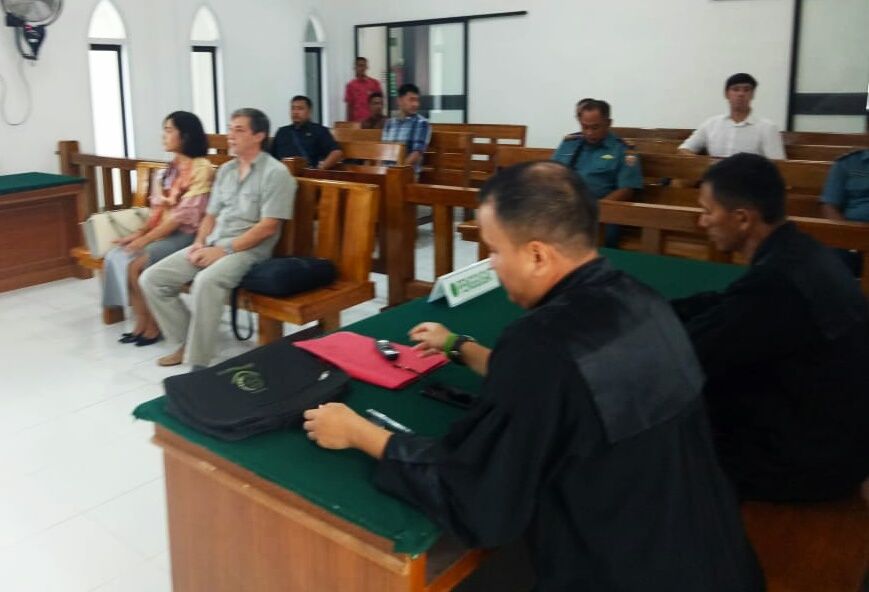
The story of STS-50’s capture can be considered something of a success. While there is no way to know exactly how much money the ship brought in over its entire career, estimates have been as high as $50 million. The sheer number of governments, conservation groups and investigative agencies that came together to stop it shows how seriously illegal fishing is now taken as a transnational crime.
Those on the front lines of protecting the world’s threatened marine resources are encouraged by another change: the increasing role played by developing nations. “I was so impressed that Tanzania committed to this pursuit,” said Hammarstedt, the Sea Shepherd captain who hunted the Thunder in 2014 and 2015 and now oversees the Sea Shepherd’s African patrols. After all, Tanzania as a nation had no stake in the matter other than helping a neighbor in the global fight against illegal fishing.
Matveev served his four months in the small, blue one-story jail on Sabang. (I approached Matveev while he was at the jail, but he declined to be interviewed for this story.) Then, on a sweltering December day with storm clouds billowing offshore, police took the former captain from his cell and drove him across town to the immigration office, where he was processed and handed his passport. With the island’s airport closed, the only way off the island was by boat.
On the drive to the ferry terminal, Matveev might have passed the Sabang Naval Base, and across the wide green expanse of lawn there, he would have been able to gaze at his old ship, which had trailed ill fortune across half the world’s seas.
It was still there, sandwiched between the naval base’s dock and the Silver Sea 2, a Thai ship caught transshipping illegal catch in Indonesian waters in 2015. Both of the enormous vessels were rocking gently in the bay—rusting, greasy monuments to our insatiable appetite for fish.
/https://tf-cmsv2-smithsonianmag-media.s3.amazonaws.com/filer/17/b9/17b9b9ff-77fa-4ae0-a2cd-8218b17a52a7/opener_mobile.jpg)
/https://tf-cmsv2-smithsonianmag-media.s3.amazonaws.com/filer/4d/bf/4dbf4870-ceaa-4fc7-aafd-38b4e4891d2b/overfishingopenerweb.jpg)
